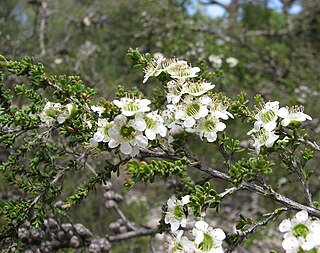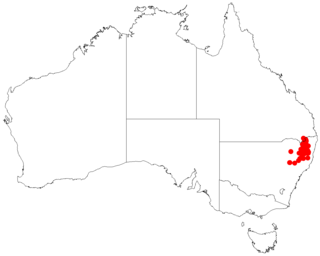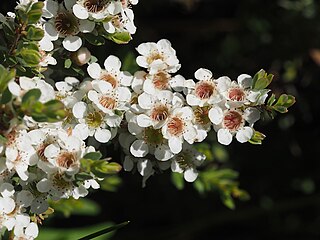
Leptospermum recurvum is a species of shrub or tree that is native to Mount Kinabalu in Malaysian Borneo and to Sulawesi. It has pale, flaky bark, broadly elliptical to almost round leaves, white flowers about 12 mm (0.47 in) wide and fruit that tend to remain on the plant for a year or two.

Leptospermum liversidgei, commonly known as the olive tea-tree, is a species of compact shrub that is endemic to eastern Australia. It has narrow egg-shaped, lemon-scented leaves, white or pink flowers and woody fruit that remain on the plant at maturity.

Leptospermum trinervium, commonly known as flaky-barked tea-tree, slender tea-tree or paperbark tree, is a species of shrub or small tree that is endemic to eastern Australia. It has papery bark that is shed in thin, flaking layers, narrow elliptic to broadly egg-shaped leaves with the narrower at the base, white flowers and silky-hairy fruit that falls from the plant when mature.

Eucalyptus porosa, commonly known as mallee box, Quorn mallee or water mallee, is a species of mallee or a tree that is endemic to southern Australia. It has rough, fibrous or flaky bark on the trunk and larger branches, smooth greyish bark above, lance-shaped adult leaves, flower buds in groups of seven, white flowers and barrel-shaped or shortened spherical fruit.

Leptospermum myrsinoides, commonly known as the heath tea-tree or silky tea-tree, is a species of shrub that is endemic to south-eastern continental Australia. It has smooth bark on the younger stems, narrow egg-shaped leaves with the narrower end towards the base, white flowers and fruit that has the remains of the sepals attached but usually falls from the plant soon after the seeds are released.

Leptospermum obovatum, commonly known as river teatree, is a species of shrub that is endemic to south-eastern continental Australia. It has egg-shaped or lance-shaped leaves that are narrower at the base, white flowers usually arranged singly on short side shoots and fruit that remains on the plant until it dies.
Leptospermum macgillivrayi is a species of small, widely-branching shrub that is endemic to Western Australia. It has hard, knobbly bark, broadly egg-shaped leaves, flowers arranged singly on short side shoots and small fruit that fall from the plant at maturity. It is only known from two locations in the inland of the state.

Leptospermum glaucescens, commonly known as the blue-green tea tree or smoky tea tree, is a species of shrub or small tree that is endemic to Tasmania. It has elliptical to egg-shaped leaves that are often greyish green, white flowers about 15 mm (0.59 in) in diameter arranged in consecutive leaf axils and fruit that remain on the plant for some time after maturity.

Kunzea leptospermoides, commonly known as Yarra burgan, is a flowering plant in Myrtaceae, the myrtle family, and is endemic to Victoria, Australia. It is an erect shrub or small tree with narrow leaves and white flowers crowded near the ends of the branches in spring.

Leptospermum coriaceum, commonly known as green tea-tree or mallee teatree, is a shrub species that is endemic to south-eastern Australia. It has smooth bark on the younger stems, elliptic to narrow egg-shaped leaves, white flowers and woody fruit. The usual habitat is mallee on sand dunes.

Leptospermum macrocarpum is a species of shrub that is endemic to the Blue Mountains in New South Wales. It has thin, hard, sometimes gnarled bark on the older stems, broadly elliptical leaves, relatively large white, pink or dark red flowers and large fruit.

Leptospermum multicaule, commonly known as the silver tea-tree, is a species of shrub that is endemic to south eastern Australia. It has linear, narrow elliptical or narrow egg-shaped leaves, white or pink flowers usually borne singly on short side shoots, and fruit the falls from the plant soon after the seeds are released.

Leptospermum glabrescens, commonly known as the smooth teatree, is a shrub or small tree that is endemic to East Gippsland in Victoria, Australia. It has linear, elliptic or narrow egg-shaped leaves, white flowers arranged singly on short side shoots and fruit that remain on the plant.

Leptospermum grandiflorum is a species of shrub or small tree that is endemic to eastern Tasmania. It has thick, elliptical to egg-shaped, greyish green leaves, white flowers about 20 mm (0.79 in) in diameter arranged singly on short side branches, and fruit that remain on the plant for long time after reaching maturity.

Leptospermum gregarium is a species of shrub that is endemic to eastern Australia. Its young stems are hairy the leaves are egg-shaped to lance-shaped with the narrower end towards the base, the flowers are white and arranged singly or in pairs on short side branches and the fruit remain on the plant at maturity. It usually grows in dense stands in swamps or along rocky creeks in high altitude place in northern New South Wales and south-eastern Queensland.

Leptospermum minutifolium, commonly known as the small-leaved tea-tree, is a species of shrub that is endemic to eastern Australia. It has relatively small egg-shaped leaves, white flowers borne singly on the ends of branches and fruit that remains on the plant.

Leptospermum sphaerocarpum is a species of shrub that is endemic to New South Wales. It has thin, firm bark, elliptical, sharply-pointed leaves, greenish white or pink flowers and fruit that remain on the plant at maturity.

Leptospermum subglabratum is a species of open shrub that is endemic to a south-eastern New South Wales. It has thin, rough bark, egg-shaped to lance-shaped leaves with the narrower end towards the base, white flowers arranged singly on short side shoots and relatively small fruit that falls from the plant at maturity.

Leptospermum thompsonii, commonly known as the monga tea-tree, is a species of tall shrub that is endemic to south eastern New South Wales. It has rough, flaky bark, broadly elliptical to egg-shaped leaves with the narrower end towards the base, and a sharply-pointed tip, white flowers and fruit that remains on the plant at maturity.

Baeckea utilis, commonly known as mountain baeckea, is a species of flowering plant in the family Myrtaceae and is endemic to south-eastern continental Australia. It is a shrub with elliptic to lance-shaped leaves with the narrower end towards the base and white flowers, usually with eight stamens.



















